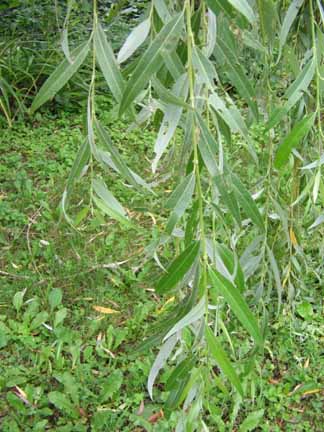Plants and People Project
Willow - Salix
"Willows are easily recognized by their long drooping branches. The leaves give off a distinct odor when crushed. The grey bark is also aromatic." Field Guide to Trees of the Eastern Region
Black willow is harvested for millwork, furniture, doors, barrels, and toys. In colonial times the wood was a source of charcoal for gunpowder. People also use willow branches in wickerwork.
Native Americans use branches from willows to make mats and to provide structures. Because of the sturdy qualities, the branches provide an excellent raw material for making a multitude of items. NativeTech.org willow
Native Americans, thousands of years ago to the present, have made animal figures and representations of peoples out of split willow sticks. NativeTech.org
Branches of the weeping willow frequently droop all the way to the ground, all the way around the tree. They create a "room" within their sheltering arms that has been a special playhouse or retreat for many children.
Willow bark contains Salicylic Acid. Willow bark tea has been used for centuries to treat fevers. In fact, its use is traced back to the Stone Age. In 1763, Rev Stone used a medicine made using willow to treat rheumatism. Aspirin was derived by recreating the salicylic acid using chemicals (coal tar). Indian Herbology of North America
The willow tree carries a hormone from which "rooting hormone" is derived. USDA Forest Service
Willows grow along streams and rivers. They serve a valuable role in stabilizing the riverbanks. They are effective in controlling soil erosion.
Willows are planted for their ornamental beauty. I consider weeping willows to be a messy tree as they shed their long branches readily. Do not plant them near your house. The roots of the willow tree can stray two to three times their drip line area, and can clog septic systems and storm drains.
Larval host plant for:
Eastern Tiger Swallowtail
Western Tiger Swallowtail
Mourning Cloak
White Admiral
Red-spotted Purple
DISCLAIMER: These pages are presented solely as a source of INFORMATION and ENTERTAINMENT. No claims are made for the efficacy of any herb nor for any historical herbal treatment. In no way can the information provided here take the place of the standard, legal, medical practice of any country. Additionally, some of these plants are extremely toxic and should be used only by licensed professionals who have the means to process them properly into appropriate pharmaceuticals. One final note: many plants were used for a wide range of illnesses in the past. Be aware that many of the historical uses have proven to be ineffective for the problems to which they were applied.
Identification and other facts / More facts / PLANTS database
Willow branch close up showing leaves


Angiosperm families off site
What tree is it? off site